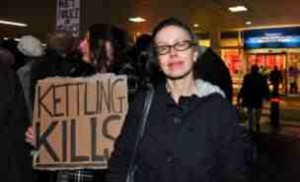By Susan Matthews, DtRtP and Justice for Alfie Meadows
If something seems to good to be true, it probably is: the belief that the police and CPS had learnt their lesson from a series of embarrassing failures to prosecute student protesters (including the Hilliard brothers and my son Alfie Meadows) in the wake of the 2010 student protests, turns out to be false. The news that three students from the Birmingham protests face violent disorder charges (http://www.independent.co.uk/student/news/three-students-charged-with-violent-disorder-after-birmingham-protest-and-could-face-up-to-eight-years-in-prison-9099733.html) suggests a return to the policy of excessive charging in response to earlier protests from the anti-Bush demonstrations of 2003 to the London Gaza protests of 2009 and the student protests of 2010. (There’s a good account of the history of recent uses of Violent Disorder by Matt Foot: http://www.standard.co.uk/news/get-protest-in-perspective-and-free-charlie-gilmour-6449546.html.) I can all too easily imagine the range of emotions the students must now be experiencing and the exhausting, frightening, all-consuming interruption in their lives and studies that awaits them if the charges go ahead.
For Violent Disorder is a serious charge with a maximum custodial sentence of five years. A common danger for protesters facing this charge is to assume that they will face merely a ‘slap on the wrist’. Believing that they haven’t done anything seriously wrong, it’s easy to think that a guilty plea offers the swiftest way through. But Violent Disorder is second in seriousness only to Riot in the charges available under the 1986 Public Order Act, and in practice it is the most serious given that Riot, which lays the police open to claims for compensation, is seldom used. (Even the so-called ‘rioters’ in 2011 did not face charges of Riot.) Yet a lot is at stake: for police, a successful conviction allows the protest to be tagged with the word ‘violent’ - and thus to be distinguished from those ‘peaceful protests’ to which all agree we have a right. Convictions function as retrospective justification for police actions. In the case of the Birmingham protest, having apparently flouted the law by demanding that protesters give their names as condition for leaving a kettle, and keeping protesters in cells for longer than the 24 hours allowed, police would like nothing more than a few convictions.
But Violent Disorder is also an insidious charge because at first glance the definition sounds much like many a protest: ‘Under section 2 of the Act, it must be proved that: three or more persons; present together; used or threatened; unlawful violence; so that the conduct of them (taken together) would cause; a person of reasonable firmness; present at the scene; to fear for his or her personal safety.’ (http://www.cps.gov.uk/legal/p_to_r/public_order_offences/#Violent)
Most protests contain ‘three or more persons present together’ and at several (being a person of reasonable firmness) I have been led to fear for my personal safety or that of others. It seems that the very act of being at a protest potentially lays you open to the charge of violent disorder. The ‘violence’ of the charge may be the chucking of a can or a balsa wood stick towards - but not reaching - a line of police. It’s important to realise that no one needs to be injured by a protester for a charge of violent disorder to be brought. Violent disorder trials often focus on producing evidence of ‘violence’ unrelated to the behavior of the defendants.
Yet in the topsy turvy world of protest law, violence by the police is rendered invisible. It so happens that I have never been afraid as a result of the conduct of protesters. But I have been afraid - very afraid - at the actions of the police.
The trials that I have attended have been distinguished by the bizarre spectacle of those who have suffered injury at the hands of the police having to defend themselves against the charge of putting others in fear for their safety. On 9th December 2010 (the day when thousands were kettled in Parliament Square and on Westminster bridge until late in the night), the official police log showed only one serious police injury – and this was subsequently discovered to be the result of a police rider having forgotten to tighten the girth on his horse and thus falling off while trying to pull the hair of a protester. Yet injuries to protesters were many and in some cases (including that of my son) life-threatening. Police tend to over-notify injuries and protesters to under-notify them but even so the figures were striking with 44 students and 6 police treated in hospital.
It seems that the charge of violent disorder at recent protests targets the few in order to dissuade the many. But police should bear in mind that trials may have the unintended consequence of throwing a spotlight on police tactics, creating a detailed and legible account of events that challenges mistaken assumptions about ‘crowd psychology’. Faced with the evidence, twelve citizens have more often than not acquitted protesters. For trials bring to light the many episodes when protesters stand together to protect each other from danger and to defend their legitimate right to peaceful protest.
Susan Matthews



